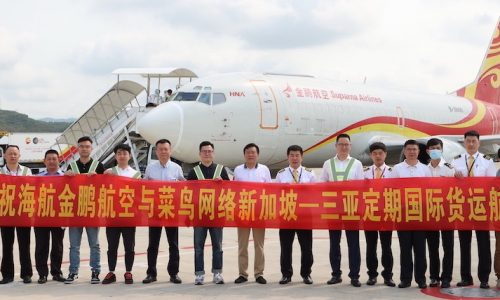
DHL Express expects shipment volumes in Asia Pacific to be 30%-40% larger than last year’s peak season, which typically starts around November and lasts until Lunar New Year.
“These investments are testament to our continued confidence in the region. They are crucial not only in the near term as we expect to tackle an unusually strong peak season, but it will make sure that we are well-positioned in the long run to keep global trade running as e-commerce and cross-border trade grow,” said Ken Lee, CEO of DHL Express Asia Pacific.
The expanded infrastructure and new flight routes across Asia Pacific will help the company tackle the unprecedented growth in shipment volume and address the ever-growing demand for time-definite express deliveries. Since the start of 2020, DHL Express has experienced a 50% surge in e-commerce shipments in Asia Pacific (excluding China).
North Asia investments
The Osaka Distribution Center in Japan scheduled to be opened by the end of 2020 will be DHL Express’ largest distribution facility in the country. With an investment of EUR 71.4 million, it will have 21,000 square meters (sqm) of floor space and is equipped with a state-of-the-art sorting system and X-ray inspection machines.
The company’s Central Asia Hub (CAH) in Hong Kong S.A.R., one of DHL Express’ three global hubs, has a EUR 377 million expansion underway that will boost warehouse space by 50% to 47,000 sqm and increase the hub’s annual throughput to 125,000 pieces per day. This means that the hub will be handling six times more in terms of shipment volume than when it was first opened in 2004.
Furthermore, a EUR 131 million planned investment in a gateway facility in Incheon, Seoul, South Korea will boost shipment processing capacity by approximately 160%, equipping it to service demand from some of the region’s most advanced economies. The expansion will almost triple the facility’s gross floor area to 58,700 sqm, making it DHL Express’ largest gateway in Asia Pacific.
South & Southeast Asia investments
In Bangladesh, DHL Express is investing ~€25 million to build a new facility that will combine its country office and service center into a 10,000 sqm site. The new facility will bring about an approximate 35% increase in shipment processing capacity, and is expected to be opened in Q1 2022.
The new Kuala Lumpur Gateway in Malaysia, which is almost triple the size of DHL Express’ current facility, will increase the company’s processing capacity by more than 200%.
The €39.4 million facility will be situated at the Kuala Lumpur International Airport and is scheduled to be completed by 2022. At the same time, construction of a new gateway facility in Bangalore, India is underway, slated to be ready by 2021.
Utilizing a brand new Boeing 777-200LRF with a capacity of up to 102 tons, DHL Express now flies four times a week from its US hub in Cincinnati and the Los Angeles gateway to the DHL Express South Asia Hub in Singapore, via Sydney.
The dedicated route shortens transit time for shipments to and from the US, and allows DHL to operate with greater efficiency while meeting the mounting demand for express deliveries.
Oceania investments
Many SMEs in Australia and New Zealand, which have traditionally relied on economy services, are increasingly switching to express delivery services.
This trend has led to a more than 40% increase in DHL Express Australia’s inbound and outbound volumes since May 2020. DHL Express has significantly increased its number of dedicated flights to and from Australia to around 30 regular services per week, compared to 10 before the Covid-19 pandemic hit.
This includes a new flight that connects Melbourne, Auckland and Christchurch, as well as a new 4x-a-week flight between Hong Kong and Sydney.
In September, the company launched its €31 million Sydney Service Center, which is double the size of the previous facility and is equipped with an automated high-speed sorting system that processes up to 4,300 shipments per hour.
By end 2021, DHL Express will kick start operations at the expanded Brisbane Gateway and Service Center, in which the company will spend €13.2 million to increase floor space by 148% and double its processing capacity. New and expanded facilities are also being planned for Melbourne and Adelaide in the near future.
Said Sean Wall, Executive Vice President, Network Operations & Aviation, DHL Express Asia Pacific: “The pandemic has caused unparalleled changes to the air cargo industry and it will likely take a long time for the industry to recover to pre-pandemic levels.
“But having a dedicated fleet and well-implemented contingency plans have helped to keep our network fully operational despite the overnight disappearance of commercial air belly cargo space.
“The growth in e-commerce shipment volumes will continue to outpace the available air cargo capacity in the industry, strengthening the case to invest in adding new dedicated aircraft to our fleet, open up new routes, and supplement our fleet with charter flights,”
DHL Express currently has 23 dedicated aircraft in its Asia Pacific fleet, and operate approximately 1,040 flights per day. The company will be adding a new Airbus A330-300P2F to its Asia Pacific fleet in February 2021, as well as a new Boeing 737-800F in March 2021.
Globally, the company has increased the number of its daily flights significantly. This includes four new Boeing 777F wide-body aircraft that were put into service just this year, with two more expected to be delivered next month.
These six additional aircraft will enable DHL Express to carry out more than 3,000 additional intercontinental flights per year.

